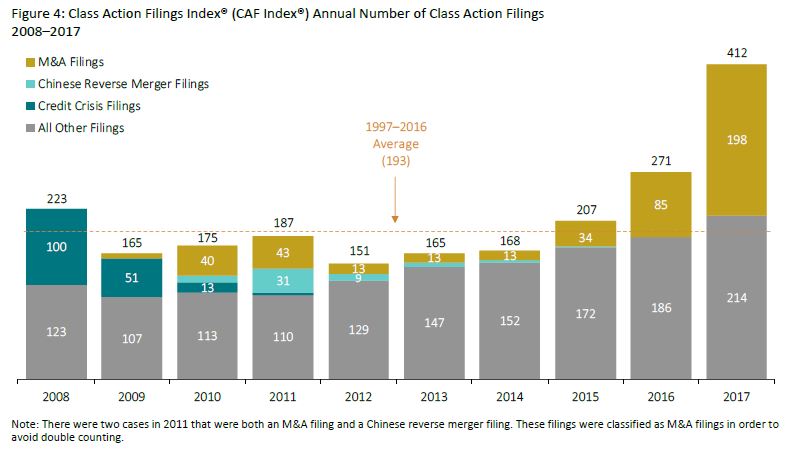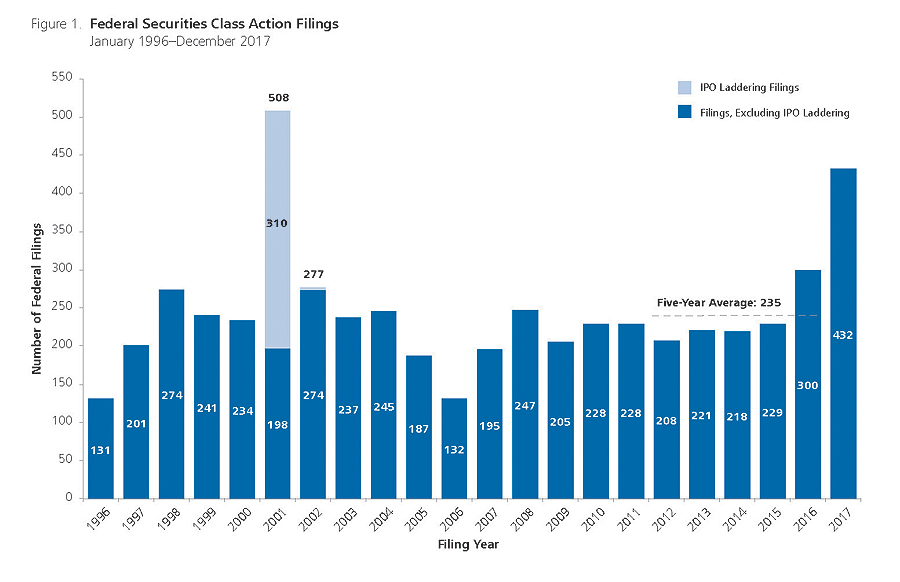 Figure 4: Class Action Filings Index Annual Number of Class Action Filings by Cornerstone Research
Figure 4: Class Action Filings Index Annual Number of Class Action Filings by Cornerstone Research
Securities class action filings hit record levels in 2017, driven primarily by lawsuits challenging mergers and acquisitions, according to two prominent studies that came out this week.
Both Cornerstone Research and NERA Economic Consulting found in annual reports that the number of class action filings brought by shareholders last year was the highest since 2008 and, when excluding the IPO craze of 2001, since the passage of the Private Securities Litigation Reform Act in 1995. Cornerstone Research’s report pegged the total at 412, up 52 percent from 2016, and NERA’s review found there were 432 filings, up 44 percent.
“The numbers are very high. The numbers are roughly at the same levels as 2008,” said Sasha Aganin, vice president of Cornerstone Research, which partnered with Stanford Law School Securities Class Action Clearinghouse on its study, released on Tuesday. But the stock market was volatile in 2008, when the financial crisis hit. “What’s interesting about 2016 and 2017 is the markets have been rising and the volatility of the overall markets was low, but filings are up.”
Both studies found that so-called merger objection lawsuits were driving the filings but that a large portion of them were getting dismissed. Cornerstone found there were 198 M&A filings in 2017, the largest number since 2009 and nearly half the total number of cases. Authors of both studies predicted more to come in 2018.
“I anticipate that merger objection filings will persist,” said Stefan Boettrich, co-author of NERA’s study, which came out on Monday. “It may not be another record number like this year, but the level they’re at is probably going to be maintained.”
Here’s some key trends coming out of the studies:
- Three law firms are driving growth. Cornerstone Research found that three law firms—The Rosen Law Firm and Pomerantz, both in New York, and Los Angeles-based Glancy Prongay & Murray—were driving the increase in filings. “It’s interesting that these firms decided that’s worth their time and effort to file lawsuits when the dollar values of the drops are relatively smaller,” Aganin said. Pomerantz’s Jeremy Lieberman countered in an email that his firm served as lead counsel in the $2.95 billion partial settlement with Petrobras this year—the largest securities class action settlement in a decade. Also, decisions on class certification in the case “have created very favorable precedent for investors, and will form the bedrock of securities class action jurisprudence for decades to come.”
- The Trulia decision is driving merger objection filings. The Delaware Court of Chancery’s 2016 decision in In re Trulia Stockholder Litigation, which rejected disclosure-only settlements, is driving much of the increase in merger objections in federal court. “We’re seeing those types of cases migrate out of Delaware and into federal jurisdictions,” NERA’s Boettrich said. Cornerstone Research reported that the number of merger objection filings in the U.S. Court of Appeals for the Third Circuit tripled from 2016.
- Dismissals are high. “Merger objection cases tend to be dismissed faster than other cases,” NERA’s Boettrich said. But it’s not just merger objection cases getting dismissed. Voluntary dismissals went from two in 2016 to 32 in 2017. “There’s a real spike in them,” he said.
- Settlement values are down. NERA found that the average settlement value in 2017 was $25 million, a drop of more than 40 percent from 2016 and the lowest since 2001. “One trend that’s behind that is the fact there not only are settlements down overall in terms of the counts but the number of large settlements or moderately large settlements are virtually nonexistent,” Boettrich said. Boettrich expected that trend to turn around in 2018 with “a substantial number of large cases in the pipeline.”
- SCOTUS already has impacted California. Filings brought in California’s state courts under Section 11 of the Securities Act of 1933 have dropped. In 2017, unlike previous years, lawyers filed identical suits in federal courts. Both are likely due to the U.S. Supreme Court’s anticipated decision in Cyan v. Beaver County Employees Retirement Fund, which could nix California state court jurisdiction over Section 11 claims, according to both studies. Boris Feldman, a partner at Wilson Sonsini Goodrich & Rosati in Palo Alto, California, said many cases have been stayed or lawyers have refused to settle until the Supreme Court makes its decision. If the Supreme Court comes down for defendants, that could end a trend that began in about 2015. “They’re going to plummet,” Feldman said of securities cases in California state court. And not just Section 11 cases—merger objection cases, too. “They scurried into federal court, but I don’t know if it was a well-thought-out strategy that will result in money,” he said.
- More cases were filed against European defendants. NERA’s report said 22 filings were against European defendants, up from 17 in 2016, and Cornerstone Research’s study found those filings reached record levels against companies in Greece and the United Kingdom. Previous filings against foreign defendants have focused on China and Hong Kong.
- New cases involve “initial coin offerings.” There were five class actions filed over so-called “initial coin offerings” in 2017, according to Cornerstone Research. Those involve bitcoin and other cryptocurrencies. “There were several offerings of those financial instruments that came under scrutiny by various regulators,” Aganin said. “Now, there are lawsuits related to that.”
Another key trend, ALM’s Kristen Rasmussen wrote, was the continuing emergence of Big Pharma and health care companies as lawsuit magnets in 2017.
 Figure 1: Federal Securities Class Action Filings by NERA Economic Consulting
Figure 1: Federal Securities Class Action Filings by NERA Economic Consulting



